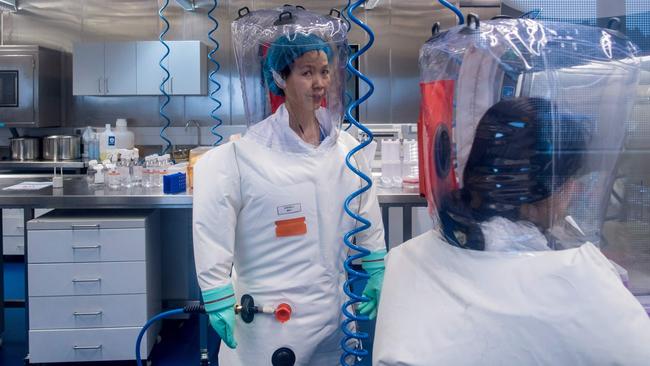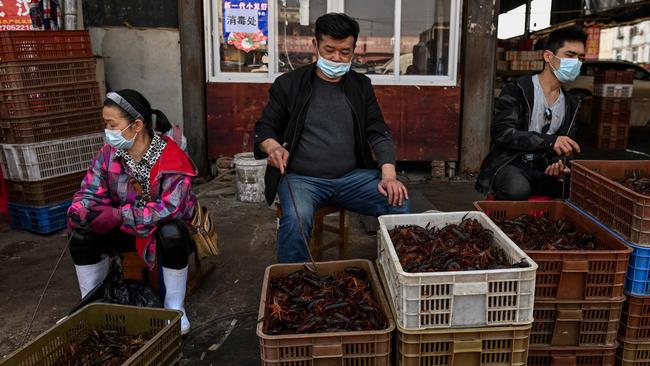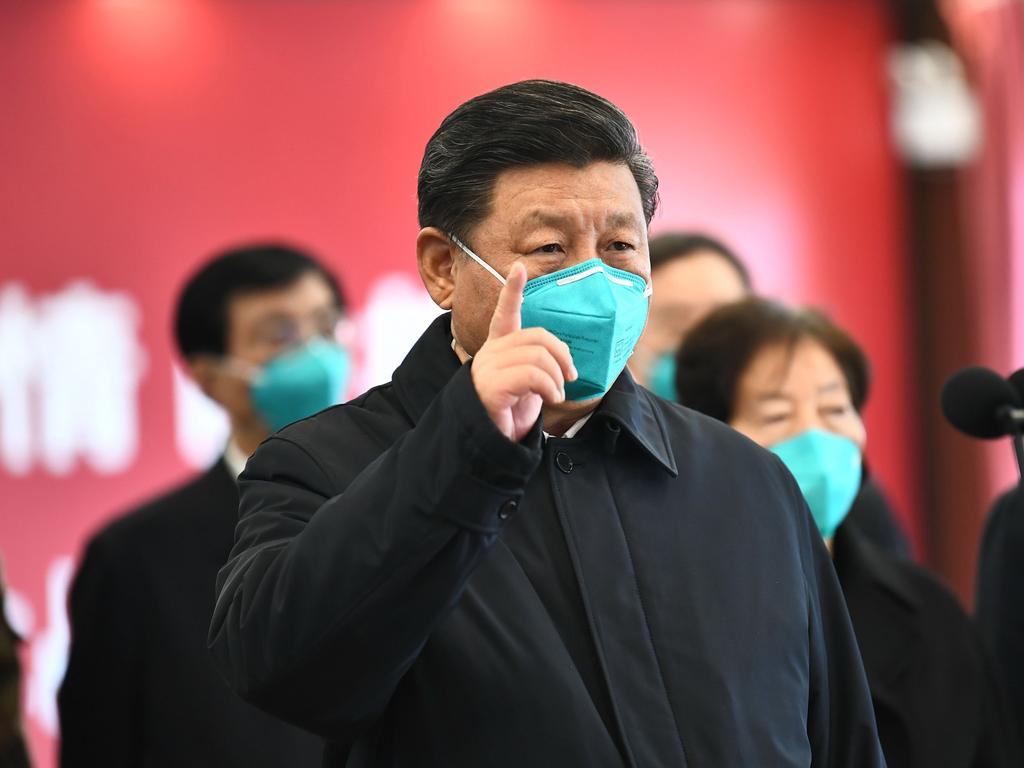Coronavirus lab rumour goes viral
Momentum is now growing behind a theory that a Wuhan laboratory, 300m from the wet market, was the source of the coronavirus.

China’s “Bat Woman” was attending a conference with colleagues in Shanghai in late December when an urgent phone call came from her boss at the Wuhan Institute of Virology.
People were falling sick from a mysterious new virus just a few miles from the institute. And Shi Zhengli, who had earned her nickname for her virus-hunting expeditions to bat caves, was summoned back to the central Chinese city to lead the laboratory’s investigations of samples taken from patients.
Momentum is now growing behind a theory that the laboratory itself — an internationally renowned centre of research — was the source of the coronavirus pandemic that has since claimed more than 150,000 lives and crippled the world economy.
That was what Shi reportedly feared, and US intelligence agencies are investigating, while the Trump administration puts the screws on China. But what is the evidence? Is this another Chinese cover-up — or politicised “baloney”, as one top US researcher claims?
Shi is an acclaimed virologist who headed the team that traced the source of the lethal outbreak of SARS — another coronavirus — to horseshoe bats in southern China in 2002-03. She was a joint author of a research paper that warned last year that it was “highly likely” future coronavirus outbreaks would originate from bats, and an “increased probability” this would occur in China.
Within eight days of her return to Wuhan in December, her team concluded the new disease sweeping the city was indeed almost certainly a new bat coronavirus. But Shi was surprised that the cases had emerged so far from the bats’ usual habitat in China’s subtropical south. In comments published by Scientific American magazine, she recalled a nagging fear: “Could they have come from our lab?”
Shi, who developed one of the world’s largest databases of bat-related viruses, frantically pored over the records at the institute. She was checking for any mishandling of experimental materials from bat virus research, especially during disposal, Scientific American reported in an article about her work last month. And she breathed a “sigh of relief” when the results showed the sequencing of the new infections did not match those of the viruses her team had sampled. “That really took a load off my mind,” she said. “I had not slept a wink for days.”
Since those early days, though, speculation that the Wuhan institute, which houses China’s top biosafety laboratory, could have been the source of the outbreak has swirled online.
It was long dismissed as an internet conspiracy theory. But amid the US and Chinese blame game over the handling of the pandemic, the scenario was pushed to centre stage last week by hawks close to Donald Trump, with the fans flamed by the President.
The possibility of a laboratory leak has also been discussed at the highest levels of the British government. Earlier this month a senior government adviser described it as “credible” and said “it is not discounted”.
The leading theory among scientists remains that the virus spread to humans from bat-infected animals at Wuhan’s now-infamous wildlife market. But findings published in The Lancet medical journal gave some cause for doubt.
According to that study, 14 of the first 41 confirmed infected patients had no direct exposure to the market. For some experts, this suggested that even if the market had a significant role in transmission, it may not have been the source. Tom Cotton, a Republican senator, has been raising questions for months. “We don’t know where it originated and we have to get to the bottom of that,” he said. “We also know that just a few miles away from that food market is China’s only biosafety level-four super-laboratory that researches human infectious diseases.”
By now the theory that the virus may have leaked from the laboratory by human error, infecting a worker who would have been “patient zero”, has become common currency among China hawks. It gained added credence last week when it was revealed that in 2018, US embassy officials in China sent warnings back to Washington about the Wuhan Institute of Virology.

In two diplomatic cables, US officials who visited the facility and met Shi expressed concerns about safety and management weaknesses at the laboratory, according to The Washington Post. One cable warned that the research into bat coronaviruses and their potential for human transmission could cause a new SARS-like epidemic. Another piece of circumstantial evidence on the desks of Trump’s national security analysts is a paper published in February by two Chinese researchers, who said the virus “probably originated from a laboratory in Wuhan”.
The authors later withdrew it, saying they did not have evidence for the theories, but the claims entered the public domain.
Evidence of the Chinese Communist Party’s attempts to cover up the outbreak at the early stages, even as Shi and her colleagues were investigating its origins, has further compounded suspicions.
In the latest revelation, internal party documents seen by the Associated Press disclosed that China’s leaders delayed warning the public for at least six days after secretly determining that the country was facing an epidemic.
On January 14, Ma Xiaowei, the top health official, laid out the grim assessment to provincial cadres, delivering unspecified instructions from President Xi Jinping.
It was only on January 20 that Xi alerted the Chinese people to the dangers of the highly contagious disease. During the six-day public silence, more than 3000 people had been infected and millions had travelled ahead of the lunar new year holiday.
Such secrecy explains why scepticism greeted an announcement by Beijing on Friday increasing Wuhan’s official COVID-19 death toll by a suspiciously precise 50 per cent — from 2579 to 3869. Chinese officials insisted the new figures reflected a more accurate count now that the epidemic had eased, not an earlier effort to conceal the severity of the crisis. Many believe, however, the figure is still way too low — and that cover-ups possibly included an accidental leak from Shi’s laboratory.
“We’re not suggesting that the Chinese had sinister intent, but that they might have screwed up,” said one Republican national security aide. “It’s perfectly possible the lab got sloppy and something got out. We know that the Chinese have been engaged in a more general cover-up over the pandemic, destroying evidence, cracking down on whistleblowers. Is it not reasonable then to ask about the origins of the virus, given there was a lab in Wuhan studying bat coronaviruses?”
In a press briefing, Trump was asked whether he thought the virus originated in a lab. He responded: “I don’t want to say that … but I will tell you, more and more we’re hearing the story. We are doing a very thorough examination of this horrible situation.”
Peter Daszak, president of EcoHealth Alliance, a US research organisation, who has worked with Shi and her institute for 15 years, is scathing about the lab accident theory. “The idea that this virus escaped from the laboratory is pure baloney,” he told the Democracy Now! TV network.
Daszak said he had collected bat samples with Chinese colleagues — “some of the best scientists in the world” — and that the Wuhan laboratory did not house the culture of bat viruses but rather their genetic sequencing. “It’s a politicisation of the origins of a pandemic and that’s really unfortunate,” he said.
Shi herself strongly rejects what she calls “tinfoil-hat” theories. “The novel 2019 coronavirus is nature punishing the human race for keeping uncivilised living habits,” she told the Caixin website. “I swear on my life that it has nothing to do with our laboratory.”
Yuan Zhiming, the director of the laboratory, denied the virus link in an interview with state media published on Saturday.
When asked if the research suggested the virus could have come from the institute, Yuan said: “I know it’s impossible.”
He said that because the P4 laboratory is in Wuhan “people can’t help but make associations”.
Reports in The Washington Post and on Fox News have both quoted anonymous sources who voiced concern that the virus may have come — accidentally — from the facility. Yuan said the reports lacked “evidence or knowledge”.
The institute had already dismissed the theory in February, saying it had shared information about the pathogen with the World Health Organisation in early January. But last week the US brought the rumours into the mainstream, with Secretary of State Mike Pompeo saying US officials are doing a “full investigation” into how the virus “got out into the world”.
The Sunday Times, AFP


To join the conversation, please log in. Don't have an account? Register
Join the conversation, you are commenting as Logout